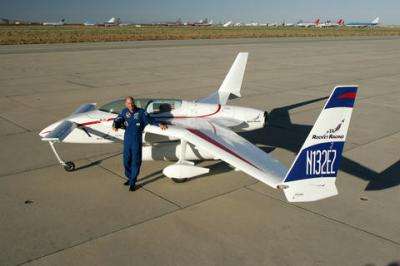July 31, 2008 weblog
Rocket Racing Could be Futuristic NASCAR Sport

With its first demonstration of a rocket-powered plane, the Rocket Racing League is hoping to have invented a new sport. Thousands of spectators witnessed the league´s first flight, held at the Experimental Aircraft Association´s AirVenture air show in Oshkosh, Wisc., on Tuesday.
"We´re using 21st century technology to create a 21st century sport for 21st century people," said Rocket Racing League CEO Granger Whitelaw. "It´s the start of a new industry, and certainly a new sports and entertainment company."
Whitelaw, an Indianapolis 500 veteran, co-founded the Rocket Racing League along with Ansari X Prize-founder Peter Diamandis. Their vision is to race planes powered by bursts of rocket fuel around a virtual 3D race course in the sky that spectators will be able to watch on projection screens.
The rocket engines, which burn liquid fuel and so can be turned on and off, will allow pilots to alternate between bursts of acceleration and gliding, with top speeds of 340 mph. Pilots will strategize on the best times to release bursts of limited fuel to achieve the fastest flights, with three or four minutes of burn time allowing about 10 minutes of racing. As the planes release their fuel, they produce 15-foot (4.5-meter) orange flames from the engines, creating a dramatic visible effect. Whitelaw and Diamandis hope that the races will one day become a kind of "NASCAR of the skies."
At Tuesday´s demonstration, Rocket Racing League officials had originally planned to stage two planes with different engines in a friendly race on an aerial 3D track. Spectators would follow along with the pilots using large television screens and helmet displays. But one of the planes, used by the league´s Santa Fe Racing Team and designed by Armadillo Aerospace of Mesquite, Texas, is still awaiting approval by the FAA. That plane is powered by liquid oxygen and ethanol.
Still, the audience still got to witness a solo flight piloted by former space shuttle commander Richard Searfoss, who flew a plane with a liquid oxygen- and kerosene-powered engine, developed by Xcor Aerospace of Mojave, California. Searfoss represented the league´s Bridenstine Rocket Racing Team, which is led by former U.S. Navy jet pilot Jim Bridenstine.
As Searfoss fired the engine for takeoff, a bright flame emerged from the back of the plane. With 1,500 pounds of thrust, the plane quickly rose to a height of several hundred feet, when the pilot turned off the engine and glided. He "popped" the engine a few more times, releasing brilliant flames in between periods of gliding.
Spectators could also view the Santa Fe Team´s plane as a display, with its engine exposed. Rocket Racing League officials hope to get FAA approval for the plane by September, when they have plans for a two-plane race at Reno Air Races. Other planned exhibitions include races at the X Prize Cup in Las Cruces, New Mexico, in October, and at Aviation Nation in Las Vegas in November.
If everything goes according to plan, the league will begin hosting competitions next year. Six teams have already signed up to participate in races, sponsored by DKNY Men, a New York City-based men´s sportswear line. At the races, fans will follow the planes´ progress by watching videos from cockpit cameras, and the league also hopes to design a computer game in which players could race against real pilots.
More information: http://www.rocketracingleague.com
via: Space.com and The New York Times





















